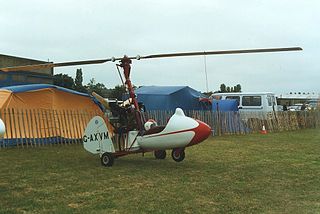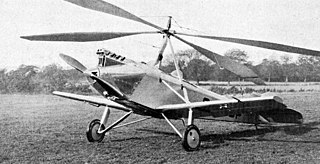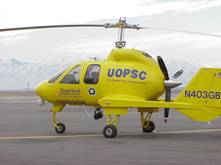Related Research Articles

The Bensen B-8 is a small, single-seat autogyro developed in the United States in the 1950s. Although the original manufacturer stopped production in 1987, plans for homebuilders are still available as of 2019. Its design was a refinement of the Bensen B-7, and like that aircraft, the B-8 was initially built as an unpowered rotor-kite. It first flew in this form in 1955, and on 6 December a powered version, designated B-8M first flew. The design proved to be extremely popular and long-lasting, with thousands of sets of plans sold over the next thirty years.
The Aerotec A-132 Tangará was a Brazilian military trainer aircraft developed from the A-122 Uirapuru of the 1960s.

The Layzell Cricket is a single-seat autogyro produced in the United Kingdom for homebuilding, although it was first produced in the early 1970s fully factory-built. It was a typically minimalist design, featuring a pilot's seat semi-enclosed within a fairing, and a pusher engine and large tailfin located aft of the rotor mast. Forty-three of the original Crickets were built by Campbell Aircraft, with the type enjoying a brief revival in 2001 when it was marketed in kit form by Mike Concannon of Cricket Gyroplanes, before reaching production again in 2005 by Layzell Gyroplanes as the Mk.6.

The Cierva C.8 was an experimental autogyro built by Juan de la Cierva in England in 1926 in association with Avro. Like Cierva's earlier autogyros, the C.8s were based on existing fixed-wing aircraft fuselages – in this case, the Avro 552.

The Cierva C.17 was a British experimental autogyro built by Cierva Autogiro Company in England in 1928, in association with Avro. It was an attempt to build upon the successful Cierva C.8 design using the smaller, more streamlined fuselage of an Avro Avian IIIA as a starting point. The type was found to be underpowered, and when the first attempt at fitting a more powerful engine still did not result in acceptable performance, the design was abandoned.

The Cierva C.19 was a 1930s British two-seat autogyro, designed by Spanish engineer Juan de la Cierva. It was built by Avro as the Avro Type 620. It proved to be the most successful and widely produced of the early de la Cierva designs.

The Kellett XR-10 was a military transport helicopter developed in the United States in the 1940s that only flew in prototype form. It was designed in response to a USAAF Technical Instruction issued for the development of a helicopter to transport passengers, cargo, or wounded personnel within an enclosed fuselage. Kellett's proposal followed the general layout that the company was developing in the XR-8, with twin intermeshing rotors, and was accepted by the Air Force on 16 October over proposals by Sikorsky, Bell, and Platt-LePage.
The Super Rotor AC.4 Andorinha ("Swallow") was a sport autogyro first produced in Brazil in the 1960s. The prototype was built by Altair Coelho and flown in 1960 as the AC.1, a typically minimalist autogyro design consisting of an open framework supporting the pilot's seat, rotor mast, engine mounting and tail fin. Power was supplied by a converted Volkswagen engine driving a pusher propeller. Francisco Mattis purchased the prototype and manufacturing rights and founded Super Rotor of São Paulo to produce the aircraft. Refinements for serial production as the AC.4 included an extra reinforcing strut for the rotor mast and a larger tail fin.

The Ryan Brougham was a small single-engine airliner produced in the United States in the late 1920s and early 1930s. Its design was reminiscent of the M-1 mailplane first produced by Ryan in 1926, and like it, was a high-wing, strut-braced monoplane of conventional design.
The Avian 2/180 Gyroplane was a two-seat, single-engine autogyro built in Canada in the 1960s. Several prototypes were built but production was not achieved.
The Ekin WHE Airbuggy is a British single-seat autogyro designed and built by the W. H. Ekin (Engineering) Company in Northern Ireland.

The Magni M-24 Orion is an Italian sport autogyro, seating two side-by-side in an enclosed cabin. It was designed and produced by Magni Gyro srl of Besnate.

The Irkut A-002 is a three-seat, pusher configuration autogyro developed in Russia through the 2000s by the United Constructor Bureau for Light Aircraft team of the Irkutsk Aircraft Production Association (IAPO) "Irkut" as the first independent product. The take-off from a place is possible when speed of a wind exceeds 8 m/s, otherwise running start up to 15 m is necessary. The riveted covering is made of duralumin. The first produced consignment consisted of five autogyros. The A-002M is a further development.
The Aero-Astra Okhotnik is a Russian single engine, three seat autogyro of pusher, pod and boom configuration. It has been developed into several variants from 2001 to 2007.

The Groen Hawk 4 was a single engine, pusher configuration, four seat autogyro built in the United States in the late 1990s. Three prototypes, two piston engined and one turboprop powered, were flown but the Hawk did not go into production.
The Hinchman H-1 Racer is a 1980s American single-seat autogyro designed by Hank Hincham with plans or a kit available from Hincham Aircraft Company for amateur construction.
The Cierva C.29 was a five-seat British cabin autogyro built in 1934 as a joint venture between Westland Aircraft and Cierva. The rotor system and rotors were designed by Cierva and the fuselage by Westland. It was powered by a 600 hp (447 kW) Armstrong Siddeley Panther II engine with a two-bladed tractor propeller; the engine also drove the three-bladed rotor via a clutched shaft. The C.29 suffered from ground resonance during ground running and was not flown. It was later acquired for evaluation by the Royal Aircraft Establishment but it was unable to cure the resonance problem and the autogyro was scrapped in 1939.
The Kharkov KhAI-24 was a 1960s Soviet two-seat autogyro designed by the Kharkiv Aviation Institute.
The SNCASE SE-700 was a three-seat passenger autogyro designed during World War II. Two were completed but only the first flew and the programme was soon abandoned.
The Windspire Aeros is an American helicopter that was designed and produced by Windspire Inc. of Long Green, Maryland. Now out of production, when it was available the aircraft was supplied in the form of plans for amateur construction.
References
- ↑ Tayor, John W. R., and Munson Kenneth. Jane's All The World's Aircraft 1981-1982 edition London: Jane' Publishing Company Limited,1981 ISBN 0-86720-592-X
- Tayor, John W. R., and Munson Kenneth. Jane's All The World's Aircraft 1981-1982 edition London: Jane' Publishing Company Limited,1981 ISBN 0-86720-592-X
- Taylor, JWR, ed. (1988). Jane's All the World's Aircraft, 1988-1989. Coulsdon, Surrey, UK: Jane's Information Group. pp. 4–5. ISBN 0-7106-0867-5.
- Taylor, Michael J. H. (1989). Jane's Encyclopedia of Aviation. London: Studio Editions. p. 915.
- Popular Rotorcraft Association website (page 17)